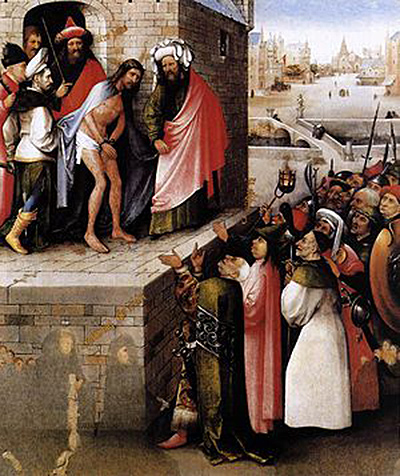Bosch painted the subject Ecce H*mo twice; this is his earlier treatment of the subject, dating from the second half of the 1470s, relatively early in his career.
Pontius Pilate says Ecce H*mo, 'Behold the Man', showing Jesus to the mob, and asking them what should be done with him. 'Crucify him!' they say, and the words, like Pilate's, are inscribed in gold on the painting like speech balloons in a comic.
At this stage in his career Bosch hadn't quite developed his personal style. The colour palette, with pinkish reds and fine greens prominent, is typical of Netherlandish painting of the time, as is the rather flat painting of the figures, without much sense of modelling.
There's a good deal of interest in the details of the costume, from the fantastic looped turban worn by one of the figures on the raised platform, and Pilate's conical red hat, to the ornate embroidered cloak and tunic of the rich man just below. Bosch illustrates fine clothing of his own day, but adds fantastic exotic touches to evoke the Biblical past.
There is a little bit of the symbolism that Bosch later exaggerates into dreamscapes - a big toad climbs up the shield held by the soldier on the right, for instance, a symbol of lust and depravity.
Bosch is also interested in the grotesque; the faces of the mob are caricatured, with bulbous noses, jutting-out lips, and ghastly expressions. They even raise weapons, and an impressively spiked lantern; they are hostile, pressing forwards, shouting.
Up in the top right hand corner, Bosch shows a city - not Jerusalem, but a contemporary town in the Low Countries, reached by a bridge over a river or canal. It seems a long way away, and rather empty.
Bosch's Jesus isn't the magnificent Christ sacrificing himself, but a humiliated and broken man, stooped and covered in blood after his beating and whipping.
That's in line with the devotio moderna, a strand of contemporary religious practice which stressed the imitation of Christ and imaginative participation in his sufferings. Beneath, the figures of the painting's donors have been partly erased, but their prayer 'Jesus save us' (Salve nos Christe Redemptor) can still be seen, written in gold paint.




